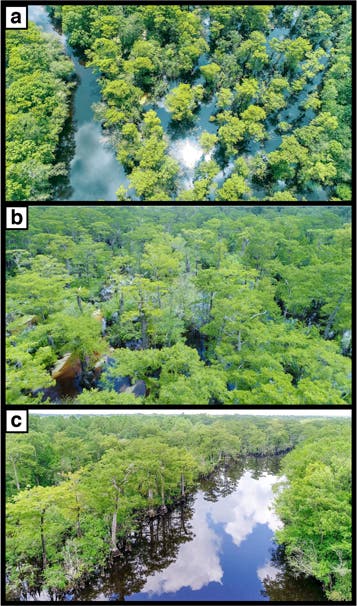A recently-documented group of bald cypress trees turned out to be some of the oldest trees in the world — and probably the oldest wetland species alive on the planet; one tree, in particular, is 2,624 years old.

The deciduous Taxodium distichum illustrated here are 1,000 to over 2,000 year old. Image credits: Stahle et al.
The Black River in North Carolina has always played an important part for the local inhabitants and ecosystems. For the early Native Americans who lived in the area, it was a vital source of food and transportation. The river served a similar purpose for European settlers until roads and railroads were developed in the area. Nowadays, while the river is no longer a major source of transportation, it is still used for recreational activities such as fishing, hiking, bird watching, and boating. But despite heavy deforestation and urbanization which threaten local habitats, a small part of the ecosystem in and around the river has managed to remain undisturbed.
David Stahle, professor of geosciences at the University of Arkansas, and colleagues, set out to document the age of trees in a long stretch of intact ecosystem along the river. They used dendrochronology (the study of tree rings) and radiocarbon dating, finding that one tree is at least 26 centuries old.
“It is exceedingly unusual to see an old-growth stand of trees along the whole length of a river like this,” Stahle said. “Bald cypress are valuable for timber and they have been heavily logged. Way less than 1 percent of the original virgin bald cypress forests have survived.” Initially, they were harvesting non-destructive core samples were all initially collected for paleoclimatic applications, but the team returned specifically to measure the age of the trees after realizing some were very old.

The top 10 oldest known trees in the world. Image credits: The University of Arkansas.
This would make the tree the fifth-oldest known non-clonal tree species on Earth, — the oldest clonal species being Utah’s Pando, an ancient aspen forest which reproduces asexually by cloning itself from an 80,000-year-old root system — the world’s oldest wetland tree, and the oldest organism in the world.
The maximum age of wetland trees has not been thoroughly documented. The previous record-holders were also growing along the Black River, but Montezuma bald cypresses (T. mucronatum) in the 1,200 to 1,500-year age class have been reported in Mexico and trees in Chile (Pilgerodendron uviferum) have been found to be at least 859-years old.

The ancient forested wetlands of Black River preserve the oldest living trees in eastern North America and represent a unique natural heritage deserving of permanent protection. Image credits: Stahle et al (2019).
The group of bald cypress trees in this study, however, seem to smash every record. They extended the existing Black River chronology by 970-years and there’s a good chance trees just as old or even older are found in the area, says Stahle, who has been working on bald cypress trees since 1985.
“The area of old growth bald cypress was 10 times larger than I realized,” Stahle said. “We think there are older trees out there still.” So far, only 110 trees have been studied, out of tens of thousands in the area.
In addition to their intrinsic value, these trees can also provide valuable paleoclimatic information about the area. Tree rings are an excellent proxy for the quantity of rainfall in each particular year or season of their life, for instance. Rings form because of the variation in growth speed through winter, spring, summer, and fall, so this growth can be correlated with rainfall and other environmental parameters.
The team is also calling for conservation of the area, to ensure that it and its ecosystems are not lost. The survival of ancient bald cypress and other tree species along the Black River provides a stunning testament to the area’s ecological integrity. Having trees of this age definitely qualifies this stream as one of the great natural wonders of North America. Unfortunately, the ancient forests and waters are both imperiled by continued logging, biomass harvesting for wood pellets and garden mulch, and water pollution from animal farms.
The study has been published in Environmental Research Communications.









